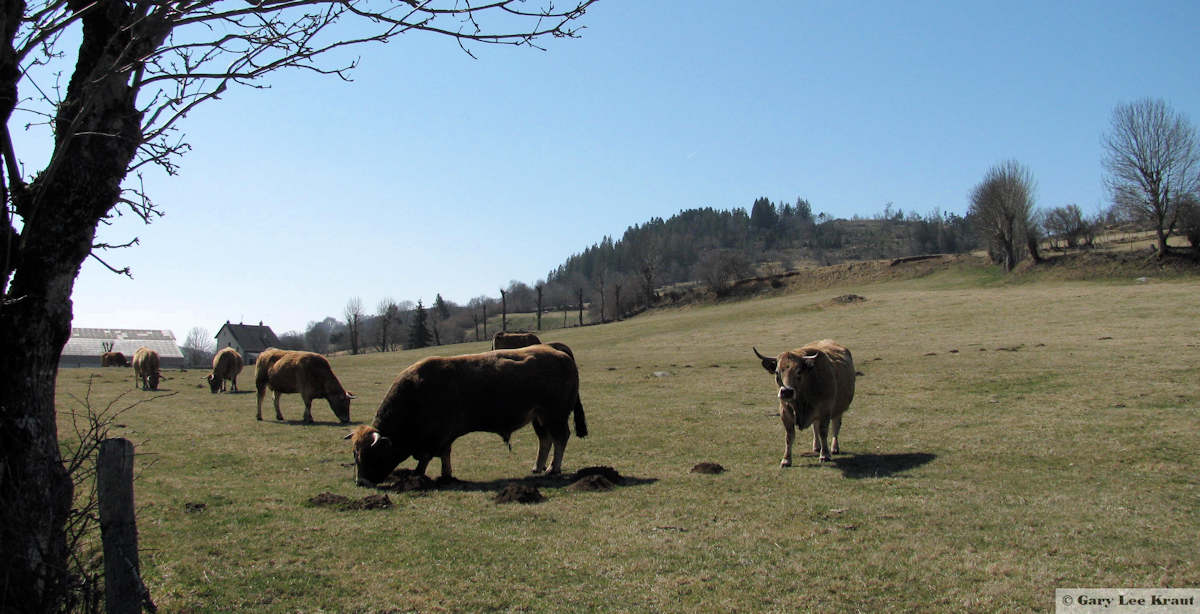
I’d had news on my phone before leaving Chaudes-Aigues that morning. It was neither good news nor bad, just news, from family. And precisely because it was neither good nor bad—for me at least—and called for no immediate reaction on my part, I was aware, in setting it aside, that I was now even further away from where I’d come. It was as though a more distant pin had been planted in the map of my trip to Auvergne as I drove onto the Aubrac Plateau. I’d traveled not just from Chaudes-Aigues, which I’d left after lunch, not just from Paris, which I’d left five days earlier, but from New Jersey, which I’d left many years before. Distance itself sparks the joy of travel.
Though the trip I’m describing took place eight years ago, I can still clearly see in my mind Aubrac’s rippling empty pastures covered with the greenish-brown grass of early spring. But I remember Aubrac more as a state of mind than an actual place on the map. In fact, if I were to look at a unlined map of the territory of France, I might not be able to find Aubrac at all. Those who dressed the map with administrative lines might not have situated it very well either since the plateau overlaps three departments—Cantal, Aveyron and Lozère—and two regions—Auvergne-Rhone-Alpes and Occitania.
No sooner had I left Chaudes-Aigues then I felt as though I’d gone as deep into France as I’d ever been. It wasn’t wilderness deep—the landscape was largely comprised of parceled, pastoral fields. It wasn’t intimidating deep—the rippling topography gave me a sense of airy calm. It wasn’t mysterious deep—I could easily read the architecture of the land. Yet it felt removed, beyond and other-worldly.
It was also deep in silence. I drove by isolated homes and farm buildings, but there was no one about, and only a few small groupings of Aubrac cattle here and there. I stopped the car, got out and listened. Silence, as they say, can be deafening. But not here. In this silence, in this depth of my travel within France, there was plenitude.
Plenitude. It’s something that I’d been feeling at times throughout my five-day drive-about. Were I to look at my photos of the Aubrac Plateau without knowing where they were taken nor that I was the photographer, I might see isolation or emptiness. But at that moment I felt that I’d arrived at a privileged place. Or should I say, in that place, I felt that I’d arrived at a privileged moment? Was this feeling of plenitude due to the place, my movement through it or simply me? That’s a question that a traveler should never ask himself? For the answer is necessarily all three, and to want to measure them separately is to doubt one’s own happiness. It’s what I’d been unable to put my finger on in Mont Dore. It’s what I’d wanted to tell Yu. That there are moments on the road when nothing looks extraordinary yet everything feels right—in this place, with this movement, within yourself.
I got back into the car and drove across the rippling pastures of the plateau that wave between 1000 and 1400 meters (3280 and 4590 feet) above sea level. The pastures, as I said, were greenish-brown. At spots in the distance I could see woods. Briefly, the Bes River flowed near the road before the road veered off. It was late March, the only season, if I can call it that, of Aubrac that I know. I’d come after the wind and snow of winter that I’d read about and before the greening of the rich grazing fields of summer that I’d seen in pictures. Other than the small groups of cattle that I occasionally passed, the herds of Aubrac cattle had yet to make their late-spring transhumance or to emerge from the barns.
I was happy to be traveling alone, and I was glad to be meeting up with someone.
Yu, I’ve been wondering about something. It’s not a question; I don’t expect an answer. After leaving Paris, where you lived two years, shortly after your 23rd birthday, you traveled much over the following year: North America, Europe, Asia. Something had changed since you left Paris. On your blog, you no longer wrote what “I” did or “I” saw, but what “we” did and saw. “We,” “us,” “our.” You’d give the reader a rare side glimpse of a young man, but never more than that. He’s never mentioned by himself. It was always “we.” I like that, Yu. I like to think that you had a travel companion and I like the mystery of not knowing anything more about him or about your relationship, simply that you were enjoying someone’s company, as a traveler should, sometimes. As I would that evening when I met Fred.

Saint Ursize and Fred “Remise”
I didn’t learn much about Fred’s background during the time that we spent together that evening and the next morning. Or, if I did, I don’t remember since, as I’ve said, this was eight years ago. I think of him now as a man who’d moved from the city to the frontier and had no intention of going back. Aubrac isn’t frontier, of course, yet it does seem to be on the fringe of something. I didn’t even learn Fred’s last name. I’d been told to call on a certain Fred Remise while in Saint-Urcize, but Remise was in fact the family name of his wife, Isabelle, née Remise, whom I didn’t meet during my stay.
Fred and I had dinner at Chez Remise, the restaurant that has been in Isabelle’s family since 1906. Chez Remise is also an inexpensive 10-room hotel, but it’s primarily a restaurant with rooms to let rather than a hotel with a restaurant. Fishing rods, other fishing paraphernalia and fishing photos decorate the dining room. There may have been fishing on Isabelle’s side of the family, but Fred is the fisherman of renown in this area and well beyond. Among his many work-hobbies, he takes clients out fly fishing for trout at his favorite spots in the Bès River and the creeks of Aubrac. The Bès River cuts south-north through much of the plateau and serves as the border between Cantal, the part that I was in, and Lozère to the east.
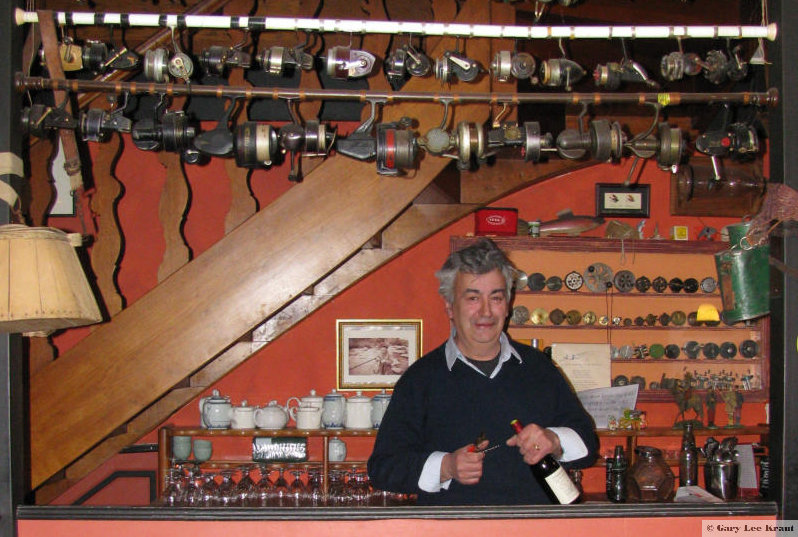
Fred is both a character and a storyteller. Even the simplest of stories that he told was spoken in the voice or with the wink of a tall tale. We shared a dinner of gizzard salad, pulled lamb, green beans and a tasty regional calorie-bomb called aligot, made of mashed potatoes, fresh cantal cheese, cream and garlic, followed by lemon pie. Even the way Fred pronounced marcillac, as he poured the wine, made it sound like a yarn. Marcillac is a red wine made mostly the mansois grape varietal and grown just west of the plateau. We clinked glasses and took a chug. I looked Fred in the eye waiting for him to say it first, until finally I remarked that it smelled like manure. It was an assessment that he neither confirmed nor denied other than to say that we had a full bottle to finish. Which we proceeded to do. The wine got no better over time, but his stories did, and by the time the lemon pie arrived I was wading with him into the river to cast out alongside a wealthy industrialist who’d flown in on a private jet to go fly fishing with him.
Fred and Isabelle also run a B&B called La Fontaine de Grégoire. Mostly Fred’s domain, it appeared to me. Fred had restored the home of a local bigwig built in 1788. It was entirely in his image: warm, welcoming and refined in a devil-may-care way. Pastoral luxury, was how I saw it and lived it as a pre-season guest for the night. Some of its five bedrooms might be considered romantic for a couple who like fine flea market finds, but there’s no mistaking the 3250-foot-square attic lounge for anything other than an incredible upstairs man-cave, though I could also well imagine it being used as an opium den. I’m not a fisherman myself, but it would seem to me that between Fred’s engaging bonhomie, his fly-fishing knowledge, his luxury B&B with the man-cave in the attic, and the restaurant Chez Remise, a group of story-swapping fly-fishing buddies could spend a memorable few days under Fred’s guidance.
Saint Urcize is at the center of the sparsely populated 500-square-mile Aubrac Plateau. At the time of my visit, the population of Saint Urcize (including the village itself, 12 nearby hamlets and forty-some farms) was wavering at around 500. 501, was the official figure. As Fred explained, “A village doesn’t exist if it has less than 500, so the local census people the village fudge the numbers.” Apparently, the numbers are no longer fudgeable since the official figure eight years later is closer to 400. (Population may have been as high as 2000 in the 17th and 18th centuries.) I assume that Saint Urcize continues to exist nonetheless. I only stayed one night, but even in an off-season the village was very much alive, with its café-restaurant-hotel Chez Remise, a grocer, a butcher and a baker.
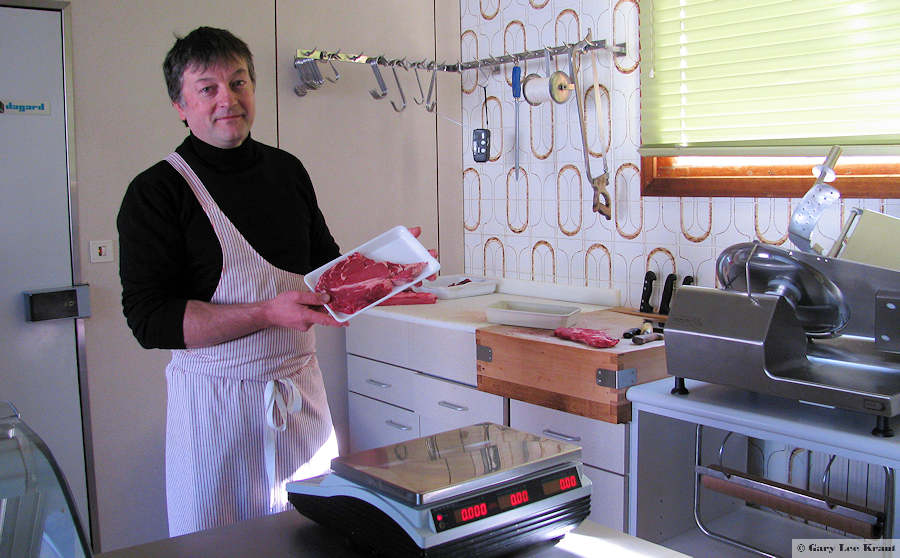
In the morning Fred took me on a tour of the village. There are more than 50 shades of grey to the granite walls and the slate and shale rooftops of Saint-Urcize.
As is to be expected, its main architectural sight is its church. It’s dedicated to Saints Peter and Michael and houses relics of Urcize, bishop of Cahors. The village once stood along the Way of Saint James, the pilgrimage route to Compostela, Spain, thus contributing to its development. Construction was launched in the 11th century, yet the church can largely be seen as the combination of a Romanesque choir from the 12th century and a Gothic nave from the 14th, to which a wall belfry was added in the late 16th century. The church also houses what legend holds to be the chalice from which Louis XVI last drank when taking communion on the morning of Jan. 21, 1793, before being led to the guillotine. The belfry rises just above the village rooftops. At night the village is silent other than the hourly ringing of the church bell.
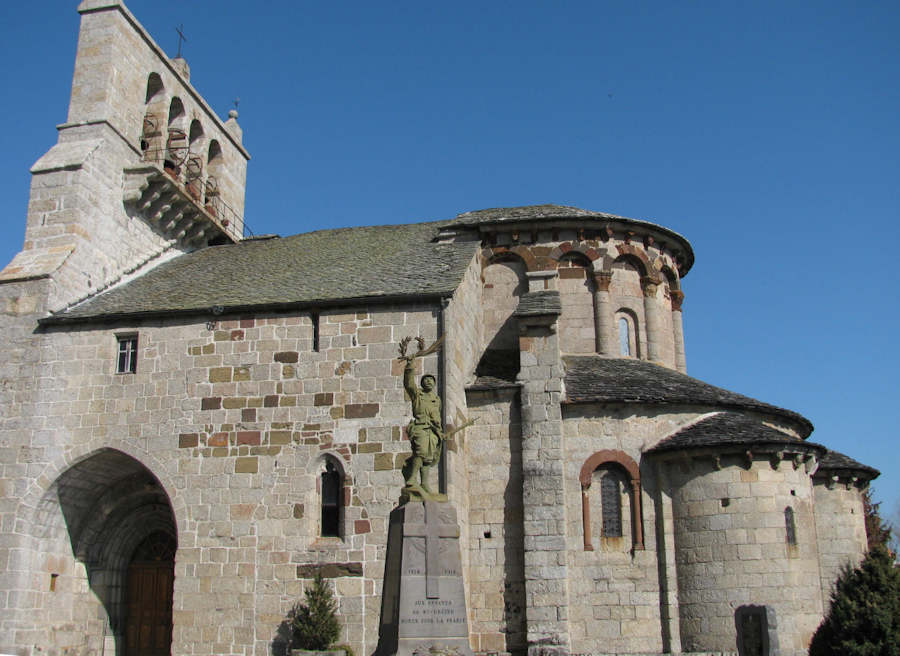
Fred and I then took a drive across the plateau to the edge of Auvergne, where we got out of the car to overlook the steeple and rooftops of Laguiole in the near distance. Laguiole, of knife-making fame, is the largest town on the plateau, with 1250 inhabitants. But Auvergne was my sole destination for this trip, so it wouldn’t have felt right to step over into Occitania. We passed a forest of beech and pine along the way, but mostly we drove alongside cattleless pastureland dotted here and there with stone huts called burons, where herders used to store cheese during the transhumance, the movement of livestock between mountain and lowland.
Aubrac continues to celebrate that most ancient tradition of cattle-raisers on the Sunday following May 25, when the barns and stables around the base of the plateau have emptied and the pastures of the Aubrac Plateau fill.
As we drove, Fred told stories of life on the plateau. I don’t remember any of them. But Fred’s weren’t stories to be remembered, rather to be enjoyed at the moment, like fish caught with pride then thrown back into the river, before casting out anew.
© 2020, Gary Lee Kraut
The Aubrac Plateau is a National Regional Park. At its center, the village of Aubrac houses La Maison d’Aubrac, which provides information about the plateau, including tourist information and where to find it throughout the area. In winter, Aubrac had cross-country and easy-going alpine skiing if snowfall is sufficient. In summer, bikes, including electric fat bikes, can be rented to sport along the rippling landscape. Saint Urcize holds a village festival on the Sunday after August 15. In September, as the days shorten and the evenings cool, the forests echo with of the rutting calls of stags in September. The transhumance is celebrated on the Sunday after May 25. Near the summer solstice it celebrates the Night of the Burons in June with music, song and cheese.
La Fontaine de Grégoire, Fred’s B&B. 15110 St Urcize. Tel. 04 71 23 20 02 or 04 71 23 20 69.
Chez Remise, the village’s premier restaurant for local fare and atmosphere as well as a modest 10-room hotel. Place de la Frique, 15110 Saint-Urcize. Tel. 04 71 23 20 02.
Information about other gites and B&Bs in and outside of Saint Urcize can be found on the village’s official website, which also provides information about events.
This is the end of the 6-part series Five Days in Auvergne. To return to the previous parts:
Part I: From Paris to Clermont-Ferrand
Part II: An Introduction to Spa Towns and Hot Springs By Way of Royat
Part III: Chatel-Guyon
Part IV: Château La Canière, a Luxury Hotel
Part V: Mont Dore, Saint Nectaire, Chaudes-Aigues and Yu


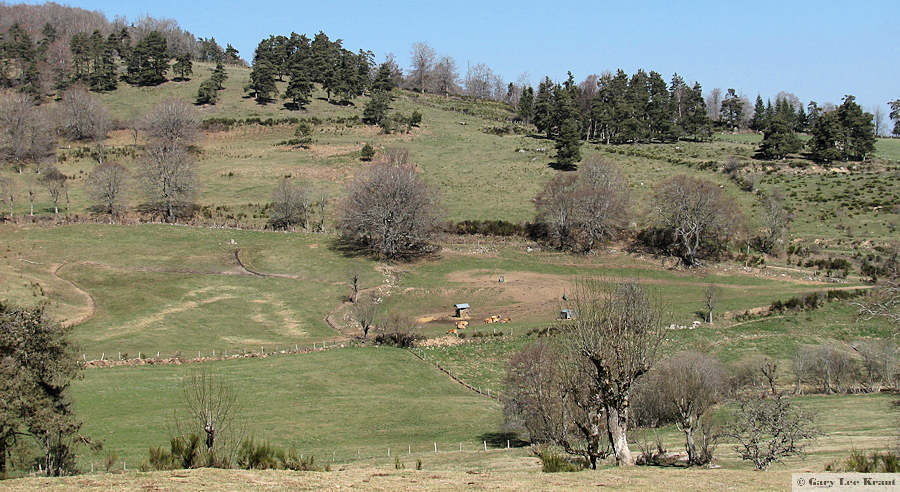
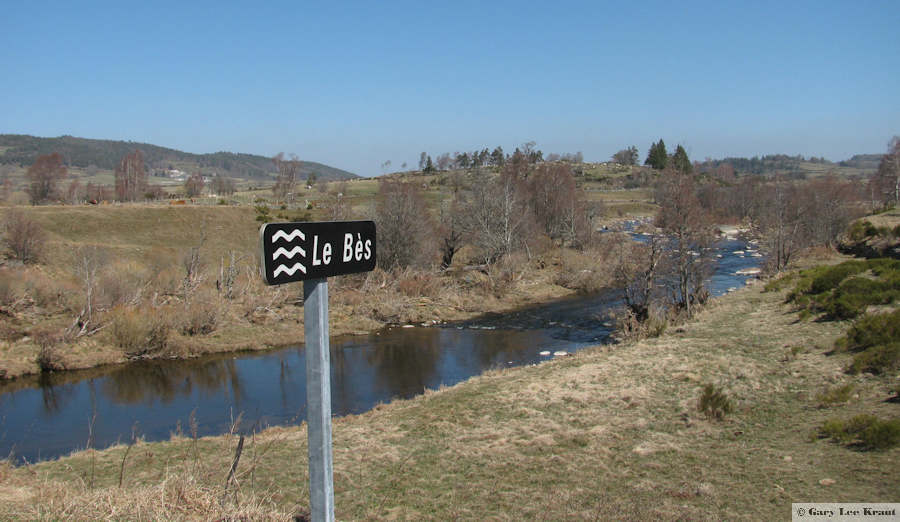
How amusing! We just returned from a week on the Aubrac plateau as part of a 3 week tour of the center of France. We began in St Leonard de Noblat after reading your other article and as a side trip to Limoges to see the famous train station that someone once suggested we visit and the enamels in the municipal museum. And now we discover this article about the Aubrac. It doesn’t sound as if another 12 years going by has changed much there. St Urcize was pretty quiet, but Nasbials had many Compostelle pilgrims. The locals said there were more visitors than usual this summer due to people seeking refuge from crowds in this least populated part of France. We had hoped to go fishing, but several years of drought has made everything dry and the Bès more of a creek than river. The cows with their “fauve” coats are still there, lovely in the evening light. We stayed in a village stable house with the traditional Cantou fireplace, well and stone sink, a ferradou for shoeing draft animals was just outside. We hope to go back to see the green grass and wildflowers one spring and ride our bikes over those rolling hills again.